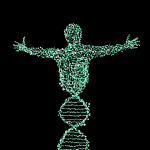Genetic reassortment, also known as genetic recombination, is the process by which genetic material from different sources, such as different individuals or strains, is combined to create new combinations of genes. This process occurs through the exchange and mixing of genetic material during cell division, specifically during meiosis, which is the specialized cell division that leads to the production of gametes (sperm and eggs) in sexually reproducing organisms.
To understand genetic reassortment, let’s break down the process step by step:
- Homologous Chromosomes: In sexually reproducing organisms, individuals inherit two copies of each chromosome, one from each parent. These paired chromosomes are called homologous chromosomes. Each homologous pair carries the same genes at corresponding positions, although they may have different alleles (gene variants).
- Meiosis: Meiosis is a two-step cell division process that occurs in specialized cells called germ cells, which are responsible for producing gametes. The process consists of two rounds of cell division: meiosis I and meiosis II. Meiosis I involves the separation of homologous chromosomes, while meiosis II separates sister chromatids.
- Crossing Over: During meiosis I, genetic reassortment occurs through a process called crossing over or genetic recombination. In this process, homologous chromosomes pair up and exchange segments of genetic material. Specifically, sections of chromatids from one homologous chromosome break and swap places with the corresponding sections of chromatids from the other homologous chromosome. This exchange creates new combinations of alleles on the chromatids.
- Independent Assortment: In addition to crossing over, another important mechanism of genetic reassortment is independent assortment. During meiosis I, the homologous pairs of chromosomes align randomly at the metaphase plate. This random alignment results in the random distribution of maternal and paternal chromosomes into daughter cells during meiosis I and meiosis II. As a result, each gamete receives a unique combination of chromosomes and their respective alleles.
- Gamete Formation: After the completion of meiosis, four haploid cells, known as gametes, are produced. Gametes contain a single set of chromosomes, half the number found in somatic cells. Each gamete carries a unique combination of alleles resulting from the genetic reassortment that occurred during meiosis.
- Fertilization: When two gametes fuse during fertilization, the genetic material from each parent combines, resulting in the formation of a zygote with a complete set of chromosomes. The zygote inherits a combination of genes from both parents, incorporating the genetic reassortment that occurred during meiosis.
Genetic reassortment is a fundamental process that generates genetic diversity in populations. It contributes to the variation observed within a species and allows for the emergence of new combinations of traits. This diversity plays a critical role in adaptation, evolution, and the survival of populations in changing environments.
In summary, genetic reassortment or genetic recombination occurs during meiosis, where homologous chromosomes exchange segments of genetic material through crossing over. Additionally, independent assortment during meiosis further increases the genetic diversity by randomly distributing maternal and paternal chromosomes into gametes. These processes lead to the creation of unique combinations of genes and alleles, ensuring genetic variability in offspring and facilitating the evolution and adaptation of species.

Leave a Reply